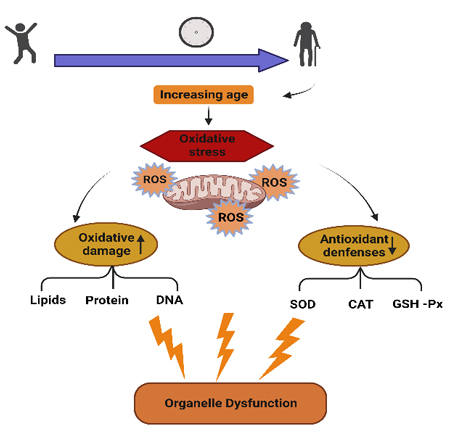
Oxidative stress and antioxidant interaction determine skin aging
Oxidative stress damage of the skin, as a fundamental factor of aging, can occur early at birth and continue through one’s entire life. Skin oxidative damage results from an imbalance between reaction oxidative species (ROS) generation and antioxidant defenses, of which unfavorable consequences, such as aging, increased skin diseases, loss of collagen and elastin, increased DNA damage, high skin sensitivity, and increased skin pigmentation can occur. The symptoms are comprised of wrinkling, sagging, fine lines, loss of skin firmness, reduction in elasticity and glow, dehydration, etc. Some examples of ROS include hydrogen peroxide (H2O2), superoxide anion radical (O2–), hydroxyl radical (‑OH), hypochlorous acid (HCLO), nitric oxide radical (NO–), and lipid peroxyl radical (LOO–). Skin ROS is mainly derived from ordinary metabolic reactions, cosmetics, and continuous exposure to oxidative environments such as UV irradiation from the sun.
Oxidative stress role in skin aging and aging-related organelle dysfunction
The reduction/elimination of the intracellularly produced ROS depends on removal by the antioxidant system. The antioxidant system consists of antioxidant enzymes and non-enzymatic antioxidants. Enzymatic antioxidants mainly include SOD, catalase, and glutathione peroxidase. Their functions are to convert oxidized metabolic products in a multi-step process to H2O2 and then to water. Non-enzymatic antioxidants mainly include a) small exogenous (natural) molecules such as vitamin E, Vitamin C, Vitamin A, flavonoids, and carotenoids; and b) endogenous (physiological) organic molecules such as uric acid, melatonin, bilirubin, and polyamines. The non-enzymatic antioxidant functions are to donate their electrons to scavenge for and to neutralize ROS.
Epigenetics regulation and control of skin aging
Epigenetics is the study of heritable changes in gene expression (active versus inactive genes) that do not involve changes to the underlying DNA sequence – a change in phenotype without a change in genotype — which, in turn, affects how cells read the genes [1]. The epigenetic regulatory system mainly consists of various mechanisms, including DNA methylation, which is mostly related to repression of gene expression through DNA methyltransferases and can be reversed to cause gene activation through DNA demethylase-directed demethylation process.
Skin aging is hallmarked by damaged macromolecular accumulations, impaired tissue renewal, and progressive loss of physiological integrity [2]. Skin aging can be classified into two types: chronological aging, which is from the passage of time and influenced by genetic or metabolic factors, and photo-aging, which is generally caused by environmental insults such as sun exposure to the skin. Both chronological aging and photo-aging can generate ROS and are accelerated by ROS. Accordingly, skin aging can also be slowed down by the reduction/elimination of ROS through the skin’s antioxidant system.
The epigenetically regulated expression of anti-oxidative stress genes generates crucial gene products — antioxidant protein/enzymes which can scavenge ROS that arise from chemical, physical, and metabolic challenges. For example, methylation of these genes results in gene inactivation and the inability to produce antioxidant protein/enzymes accordingly. In contrast, demethylation of these genes causes gene activation to generate functional antioxidant protein/enzymes.
The skin’s antioxidant system consists of two defense layers. Layer 1 is the skin’s epidermis, which provides endogenous antioxidant action. As an initial barrier to oxidant assault, the epidermis contains up to 700% higher antioxidant enzyme activity (e.g., catalase) and up to 900% higher non-enzymatic antioxidant activity (e.g., Vitamin E) than the dermis [3]. These antioxidant components can be released from the keratinocytes of the epidermis to the skin surface. Layer 2 is the skin’s microbes which provide necessary antioxidant action. There are approximately one million bacteria per cm2 in human skin. The microbiome is an integral part of the skin barrier that can affect skin health by modulating host immune responses and the skin barrier functions. Common bacteria on the skin can secret antioxidant substances, including RoxP to protect the host skin from oxidative stress [4].
Epigenetics-targeted skincare antioxidants and their actions in preventing skin aging
Antioxidant skincare products can also provide exogenous antioxidant action and may be considered as “Layer 3” of the skin’s antioxidant system when appropriately applied. Among skincare products, nearly 90% claim to have an antioxidant function. These products contain more or less antioxidant ingredients, which mainly include non-enzymatic antioxidants: vitamin A, vitamin C, vitamin E, glutathione, carotenoids, and various plant polyphenols such as tea extracts. The antioxidant mechanisms and epigenetics-targeted action of these ingredients are listed in the following table.
| Antioxidant | Antioxidant Function | Epigenetic targets | References |
| Vitamin A | Single O2 quencher | Decrease DNMT expression | [5,6] |
| Traps peroxyl radicals | |||
| Vitamin C | Free radical scavenger | DNA/RNA demethylation | [7,8] |
| Regeneration of vitamin E | DNMT inhibition | ||
| Vitamin E | Lipid peroxidation inhibition | Decrease DNMT expression | [9,10] |
| Single O2 quencher | |||
| Glutathione | Free radical scavenger | Indirectly decrease DNMT | [11,12] |
| Regeneration of vitamin C/E | and DNA methylation | ||
| Carotenoids | Free radical scavenger | DNMT inhibition | [13,14] |
| Single O2 quencher | |||
| Polyphenols | Free radical scavenger | Decrease DNMT expression | [15,16] |
| Lipid peroxidation inhibition | Reduce DNA/histone methylation | ||
| ROS decrease |
Extensive evidence shows that epigenetics-targeted antioxidants are the most effective against oxidative stress damage to skin cells and tissues and, as a consequence, significantly prevent or slow down skin aging. It should be emphasized that skin status is dynamic, generated by environmental interaction, and reversibly regulated by epigenetics at the gene and protein levels. Thus, the skin’s antioxidant level will be decided upon eventually by the activity of enzyme and non-enzyme molecules on the skin.
Practical skincare requires easily accessible insights into one’s own skin and skincare products. Simple skin antioxidant self-tests have recently emerged for consumers that could help to know one’s skin antioxidant level as well as determine which skincare products are most appropriate. In addition, it is also important to know whether or not antioxidant-specific skincare products are truly functional. Even if these products claim to contain antioxidant ingredients, the actual effect may be dependent on the ingredient amount, potency, and the combination of multi-ingredients. Thus, before applying to the skin, checking if these skincare products actually protect against oxidative stress would be necessary for obtaining skincare antioxidant products that are truly effective and suited for users.
References
- Epigenetics: Fundamentals. www.whatisepigenetics.com
- Orioli D et al: Cells. 2018, 7(12), 268; doi.org/10.3390/cells7120268
- Shindo Y et al: J Invest Dermatol. 1994;102(1):122-4. doi: 10.1111/1523-1747.ep12371744.
- Andersson T et al: Sci Rep. 2019; 9(1):3596. doi: 10.1038/s41598-019-40471-3.
- Fazi F et al: Oncogene.2005,24(11):1820-30. doi: 10.1038/sj.onc.1208286.
- Olson JA et al: J Nutr Sci Vitaminol. 1993, 39: S57-S65. doi: 10.3177/jnsv.39.supplement_s57.
- Macam AM et al: Antioxidants. 2019, 8(8), 247; https://doi.org/10.3390/antiox8080247.
- Blaschke K et al: Nature. 2013, 500(7461):222-6. doi: 10.1038/nature12362.
- Remely R et al: Nutrients 2017, 9(6), 607; https://doi.org/10.3390/nu9060607.
- Ni Y et al: Clin Cancer Res. 2012, 18(18): 4954–4961. doi: 10.1158/1078-0432.
- Gaucher C et al: Antioxidants. 2018, 7(5): 62. doi: 10.3390/antiox7050062.
- Lengo AM et al: Epigenetics. 2020, 15(12): 1348–1360. doi: 10.1080/15592294.
- Young AJ et al: Antioxidants. 2018, 7(2): 28. doi: 10.3390/antiox7020028.
- Tremblay B et al: Nutrients. 2019, 11(6): 1265. doi: 10.3390/nu11061265.
- Fang M et al: J Nutr. 2007, 137(1 Suppl):223S-228S. doi: 10.1093/jn/137.1.223S.
- Cherubim DJL et al: J Cosmet Dermatol. 2020, 19(1):33-37 doi: 10.1111/jocd.13093.


